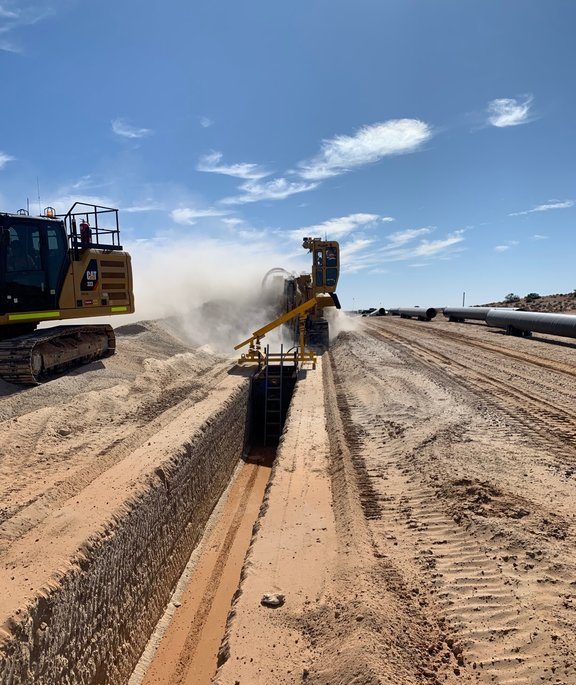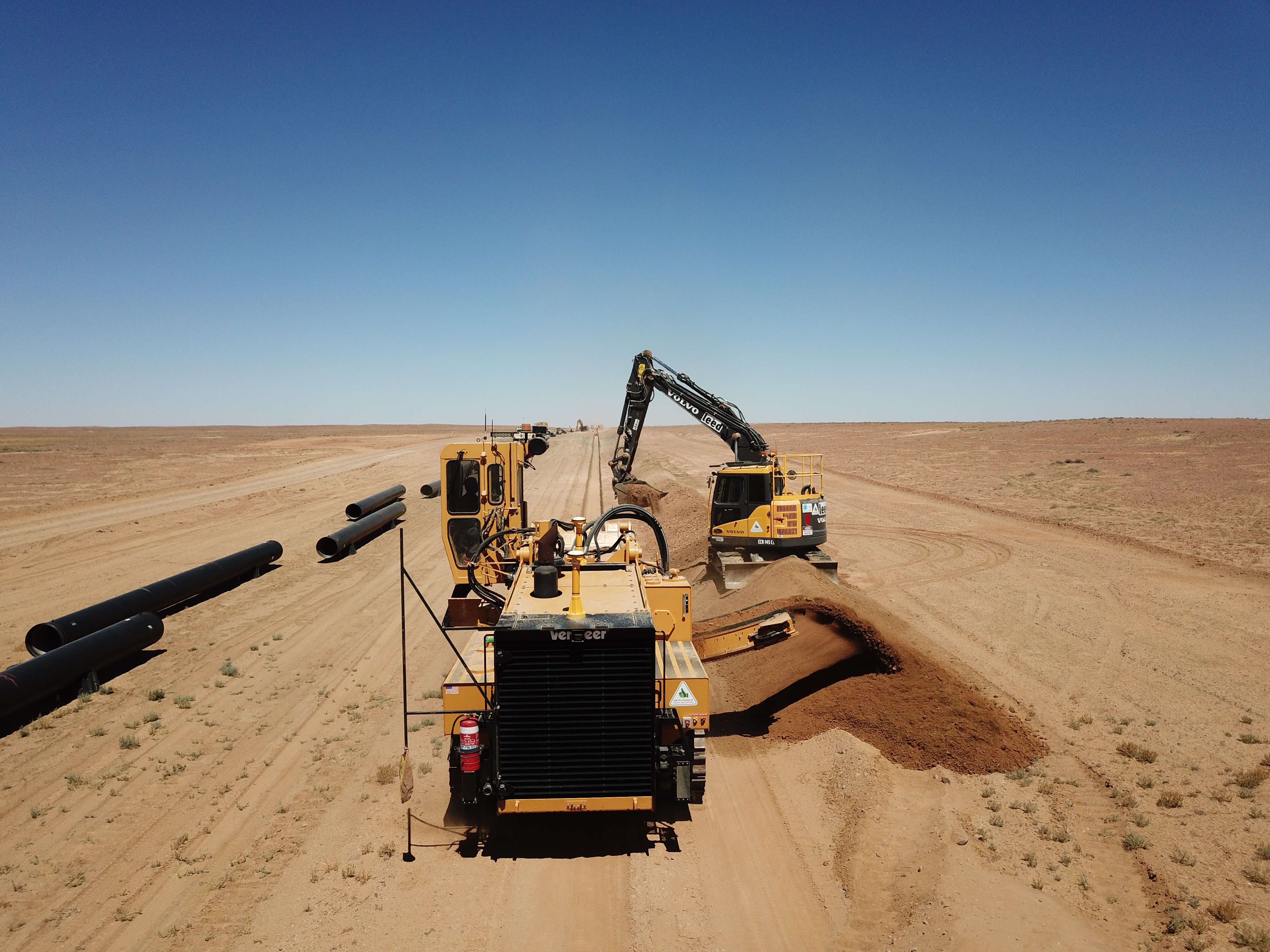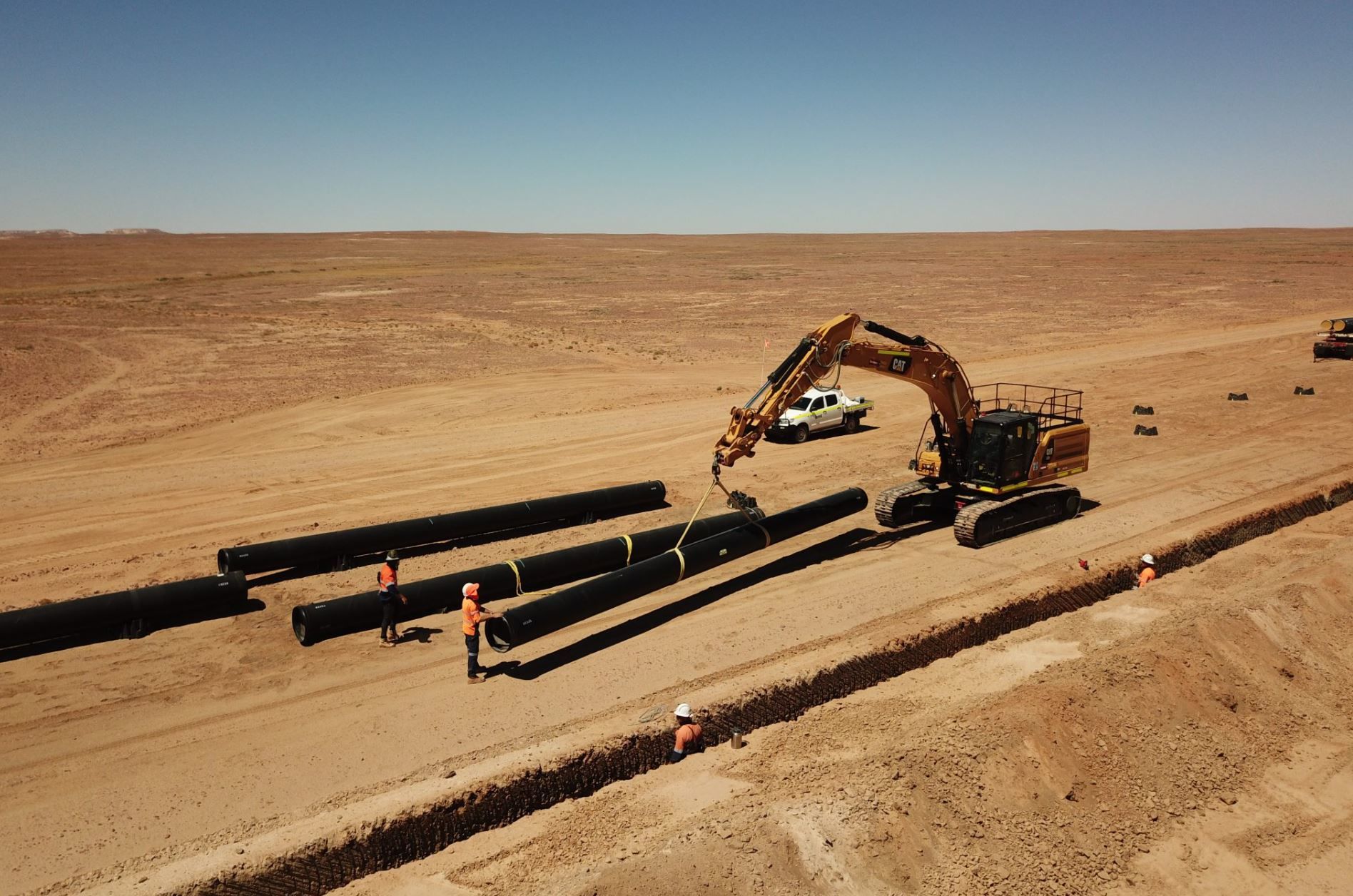Founded in South Australia in 2001, Leed Engineering is a privately-owned engineering and civil construction infrastructure company that specializes in water projects that include dams, pipelines, water treatment plants, pump stations, water storage and sewer throughout Australia.

Overview
The Olympic Dam mine, owned and operated by BHP, is a large poly-metallic underground mine located in South Australia with significant deposits of copper, gold, silver and uranium. In fact, the underground mine is made up of more than 450 km of underground roads and tunnels.
Business Challenge
Dig trenches for new pipeline replacement project with speed and accuracy.
Currently, the M6 pipeline transfers up to 390 litres per second of raw water from the Great Artesian Basin (GAB) Wellfield B to the Olympic Dam site and Roxby Downs through three pump stations. The M6 pipeline was originally constructed in 1997 and is undergoing a renewal program due to a history of failures, primarily resulting from external corrosion. The ongoing deterioration of the existing pipeline is a risk to process and potable water supply.
To help overcome the challenges faced by the deteriorating infrastructure, BHP engaged Leed Engineering and Construction Pty. Ltd. to replace a 67 km section of the existing 196 km long M6 pipeline. BHP chose Leed Engineering for a number of reasons, and they are also benefiting from safer worksites, faster workflows, and more accurate as-built data.
The project aimed to replace extreme risk sections of the M6 pipeline in three sections on the Pipeline track between the Borefield road and Muloorina Station. The existing pipeline was replaced with cathodic protected DN600 Sintakote Rubber Ring Jointed (RRJ) Mild Steel Cement Lined (MSCL) pipe at a 10-metre offset from the existing pipeline.
The 67 km of pipeline was replaced and all replacement pipework buried. Other key tasks associated with the project included installing valve pits, performing tie-ins, installing and testing of galvanic cathodic protection and hydrostatic testing of the new pipeline.
Although placing pipeline is seemingly straightforward, and Leed Engineering does this exceptionally well, recent technology advances helped improve productivity of the M6 project by upwards of 50%. The system performs even better when working through a radius, as there is reduced or no need for stakes, or a surveyor to visit. Craig says, “We’re staking out maybe one tenth of what we’d normally stake out”. Grade Adjustment
Grade Adjustment
Pipeline renewal requires crews to not just dig and place new pipeline, but to locate and document the new components with precision. On past pipeline trenching projects, Leed Engineering crews have relied on grade lasers to dig the trench and manually spot the pipe joints with GPS to supply accurate coordinates for where each pipe is in the ground.
However, grade lasers didn’t provide consistent accuracy. Matt Foster, Trencher Operator for Leed Engineering, said, “With a laser it might be 100 mm off, due to a false reading or dust in the air, and we need visual line of sight. When it’s dusty, we have to stop. And with every grade change, we had to move the laser. If we had 10 grade changes in a day, at half an hour to reset the laser, it adds up.”
Due to continued re-establishment time of the grade laser, through changing terrain, the trenching crew would be working longer days to keep ahead of the pipelay crew. Trench digging with the laser survey method required crews to dig as much as 15-hours per day, in two shifts to keep ahead of pipelaying production. “Our goal on the M6 project was to increase productivity and reduce fatigue on operators,” Foster said. Visual Opportunities
Visual Opportunities
After talking to SITECH Construction Systems Pty Ltd in Queensland, Leed Engineering invested in a Trimble Trenching Machine Guidance system with 3D visualization and accurate trench depth monitoring to within +/-20 mm. Installed on the Vermeer T1055 Track Trencher, the Trenching Machine Guidance system includes an MPS865 GNSS receiver and two rugged antennas on short masts with two dual axis inclinometer sensors, along with an in-cab monitor.
When activated, the Trenching Machine Guidance system provides accurate positioning relative to the design, vertical measurement to the bottom of the trench, presented as a colour-coded interface to help the operator determine precise pipe location. Speed and Efficiency
Speed and Efficiency
For every segment of the project, the project engineer would build an AutoCAD model, which was sent to the Trimble Trenching Machine Guidance system on the trencher.
Craig Watkin, Project Manager for Leed Engineering, confirmed, “We don’t dig faster metre by metre, but in a day, we would definitely increase productivity by up to 500 metres because we don’t have to stop and move a laser. With the laser we could lose several hours in a day. Now, depending on ground conditions, we can dig anywhere up to 1,000 metres per day.”
Callum Cusack, Project Engineer, agreed, adding, “Every 5 metres, we have a point for as-built measurements that we capture with the rover to double-check quality of the work completed, and those as-built measurements are always within 20 mm of the design.”
Foster added that’s a big change from previous methods. The Trimble Machine Guidance system allows us to work in any conditions,” he said. “We still need to record as-built information once the pipe is placed, but the entire process is more accurate and streamlined. We can dig a productive day quite comfortably 1,000 metres within 8 hours. We may not dig faster, but we are more consistent.”
“Digging the trenches is no longer a critical path,” said Steve Lancaster, Superintendent for Leed Engineering. “Critical path has now shifted to pipelaying and backfill.” He further noted that the increase in productivity has provided redundancy benefits as well. If a machine goes down, production stops on a project such as the Olympic Dam pipeline replacement project. Now, trench digging crews have a buffer and don’t have to work longer days to catch up. Benefits
Benefits
• Faster trenching workflows saving up to hours per day
• More detailed and more accurate (<20 mm) as-builts
• Uninterrupted operation despite high-vibration, atmospheric dust, or limited daylight
• Safer job sites with lower labour costs

Solutions
Trimble Trenching Machine Guidance system including:
• MPS865 GNSS receiver
• Dual axis inclinometer sensors for pitch and roll in a marine grade submersible enclosure
• Rugged Trimble Zephyr dual antennas on short masts

Quotes
I can see it being beneficial on both large and small projects as we can reduce the survey time component to maximise the productivity. And, more importantly, there are safety benefits as we can now reduce the risk of people working near moving plant and in trenches.
Craig Watkin,
Project Manager for Leed Engineering
The Trimble trench guidance system, can be installed with minimal downtime, to provide productivity and safety improvements, says Brent Dawson, Technical Consultant at SITECH Construction Systems. He adds, “The interface is easy to use with operators requiring minimal training and support is available via remote screen sharing. It also provides constant logging for quality assurance and billing purposes, removing the need for rework and collection of as-excavated data.
Brent Dawson,

